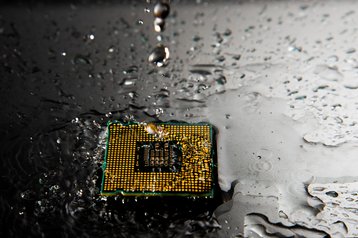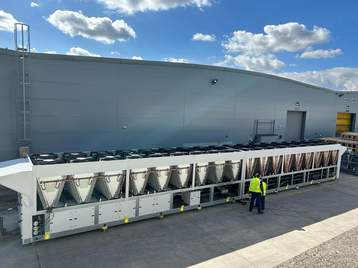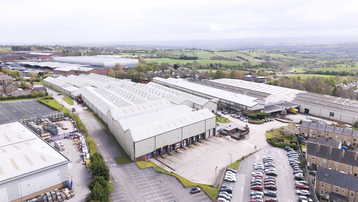Data center operators are facing massive decisions as they prepare their facilities for the next decade and the ever-accelerating growth of traffic brought about not just by AI, but the insatiable demand the world’s population has for data in general: New-build or retrofit? Air cooling or liquid? Location or latency?
Airedale by Modine is one of the world’s leading suppliers of end-to-end cooling solutions and has been working hand-in-glove with the industry to find answers to these burning questions, along with many more. Richard Burcher is the global product manager for liquid cooling at Airedale and DCD met up with him to discuss the future of the data center, the factors influencing cooling decisions, and why the future is hybrid.
“The future of data center cooling is becoming increasingly hybrid, incorporating a mix of air and liquid,” he tells us. “That trend is driven by the need for more efficient, sustainable solutions in managing the heat generated by these higher-performance servers, including next-generation CPUs and GPUs, which drive up the thermal design power at the chip itself.”
Although air-cooling has been refined to offer a realistic option for larger loads than ever before, it cannot cope alone with the heat being produced by modern high-performance compute and artificial intelligence workloads. Liquid cooling can take the heat but involves more complex maintenance, increased cost, and additional infrastructure requirements, meaning it is often overkill for loads that can be cooled by air. However, as Burcher tells us, a combination of the two can be greater than the sum of its parts:
“The hybrid solution enables data center operators to balance the benefits of both air and liquid cooling based on the specific needs of the compute and the infrastructure. At present, only particular loads require liquid cooling, and by taking a modular approach, with a holistic vision, data centers can meet the needs of all kinds of workloads”.
“It's not about ripping out everything in existing facilities where the building is already in situ but augmenting it. It's applying the hybrid additions to densify pockets within your data center, which is particularly useful if there are mixed density loads and/or power constraints preventing a move to full liquid cooling overnight. Whilst AI and high-performance compute workloads attract media column inches, the broader impact of AI/HPC on the data center industry will take time to materialize fully. Whilst server rack densities are increasing to support more demanding compute, the average remains in that 5-15kW band. There is a trajectory for growth, but many colos report average rack densities of 10-12kW and some hyperscale/CSPs, around 15kW. With a hybrid methodology, the data center operator can create specialized zones within the data center building, catering to the different requirements of compute”, says Burcher.
For multi-occupant data centers, better known as colocation or ‘colo’ facilities, there are additional considerations, as hyperscalers turn to the colos to expand their operations at speed, often hiring out complete facilities “off plan”. For the hyperscaler, it represents an opportunity to scale out at pace, mitigating risk and allowing them to quickly expand into new areas. For the colo operator, that presents both an opportunity and a challenge, because in order to attract a hyperscaler, you have to think like one. Burcher takes us through the reasons this is happening:
“Colos are increasingly having to think like hyperscalers in terms of kitting out their environments. In essence, there's a convergence of factors – scalability, speed, cost-effectiveness, agility, technology availability…alongside additional market dynamics like land and power availability, that lead colo providers to think like hyperscalers.”
As new technologies emerge, the hyperscalers are best placed to bring them into use first. That means, for the colos wanting to attract a hyperscale client, they must be ready:
“The new generation of GPUs and CPUs are going to be taken by the hyperscalers, first and foremost, because they've got the capital. They're also getting pressure in terms of providing a faster return on investment and that's why they're leaning into colos. It’s opex rather than capex. They’ll pass on the design risk to the colos and dip their toes into a new industry at the same time.”
For Airedale, selecting the right type of cooling is just the beginning, and a holistic approach also involves looking at the system control required to ensure that different areas of the data hall are at the correct temperature. Many data centers are still using off-the-shelf building management systems (BMSs) to control the environment in the data hall. Burcher warns that in the age of multi-zoned, modular, hybrid cooling systems, a generic BMS simply doesn’t cut it:
“Asking a BMS to manage complex variable flow fluid systems and optimize large-capacity cooling units, all while responding to the load fluctuations that high density compute will throw up, is akin to bringing a knife to a gun battle. Hybrid cooling systems need dedicated control platforms to properly manage and optimize them. The industry must continue to wake up to this and see the benefits that can be delivered via dedicated system control platforms. The BMS is a critical reporting tool, but it shouldn't be managing cooling systems. The key is shifting from an events and set-point-driven approach to a more deterministic system that dynamically modulates equipment in response to temperature and pressure conditions at rack level.
This applies whether you choose a new build facility, retrofit an existing one, or repurpose an existing building such as a disused steel mill or warehouse. Burcher points out that retrofitting or repurposing has multiple advantages in terms of sustainability and speed-to-market:
“It's important to look at ESG goals and the fact that the greenest of all green buildings is the one that is already built because you've got the building, the infrastructure, and that building is going to last a hell of a lot longer than the IT within. What is critical, however, is the adaptation that can be realized within that building. Immersion tanks are notoriously heavy, for example, so direct-to-chip might be a more salient approach for a repurposed building.”
But on the flip side, a brand new, greenfield site allows the operator to build from a blueprint with the best of all possible setups for their compute needs. That’s where bringing in partners like Airedale early can pay dividends: “You're designing from a blank sheet of paper. You're not inheriting unwanted raised floors, infrastructure, floor voids, and antiquated design decisions. You can bring uninhibited ideas in from the offset, and get the right people around the table to realize them. The best time to start thinking about cooling is Day 1. Plan in your chilled water loops, pipework, and all relevant associated infrastructure to support hybrid right from the start. You can bake reduced energy costs into the design and create a facility that is designed for the compute processing required today, with flex for tomorrow.”
We turn to the question of AI itself and ask Burcher if he thinks that we will see a move toward data center optimization through machine learning to further fine-tune zonal temperature and optimize cooling, and whether it will eventually replace the human element. Here, too, he sees a hybrid future: “The two will work in unison. When we talk to our customer base, not many are looking for AI to take over and do everything, because in our industry, there are issues of resilience and uptime. AI is still continually learning, and it's not at the end goal as of yet. Risks need to be carefully managed all the way through, including things like fail-safe processes and overrides that require you to simulate what you're doing before you unleash AI in a “Skynet” approach! We have discussions with operators who have experimented with AI for things like automation of tasks. Adoption will continue, with caution, as trust in AI for operational decision-making continues to be questioned in DC operations. In discussions that we have, a lack of accountability, transparency, and concerns around cybersecurity by adding further network connections remain, and are seen to add additional points of failure.”
With the rise of the machines put firmly in its place, it is clear that for a perfect cooling strategy, partnership is everything, and Burcher is clear that Airedale is that partner:
“We are technology-led, first, second, and third. We're engineers by trade and by mindset. We strive to understand the problems we're solving and that's a key point. We want to always be at the cutting edge, delivering high-performance, next-generation systems that are better every time. There’s a real connection between our commercial teams, our delivery teams, our software teams and our product development teams that you don’t find in other large organizations. This brings the whole business closer to the customer and allows us to fine-tune products for today while developing solutions for tomorrow.
“Mutual trust is a big one,” he continues, “You've got to have trust in this industry. Not everything goes right all the time, so you have to trust the providers that you're working for. We establish trust through reliability, integrity, and accountability. The word partnership in business is well known, and often it's a bit of a cliche, but we don't want customers who come and go project by project. We want to grow with them, take the applied learnings, and continuously improve along with them.”
Talk of problem-solving and partnership alongside Airedale is an element where Burcher speaks with an unmistakable zest. We ask him how the business is ramping up to meet the incredible increases in demand for its services:
“We're scaling up at an impressive rate across the globe in terms of our capability and capacity. We've gone from one/two plants to six global manufacturing facilities throughout the UK, Europe, and North America, and we've got plans to expand into Asia. The key to successful growth is to protect and nurture the core of what you do well and our HQ in Leeds is our global epicenter for research, design, and quality manufacturing. This center of excellence approach allows us to replicate the Airedale way of doing things throughout the territories we serve.”
Though a global business, Airedale remains proud of its UK roots and has recently invested in expanding UK production, along with several other key locations around the world: “We're driven by demand, as the whole industry is, but we're also driving innovation. Our third UK plant, a 14.6-acre site in Bradford, will allow us to increase our capacity by 150 percent. We continue to maximize our global capacity and our operational excellence.
“We're putting a lot of capex investment into Rockbridge, Virginia, Grenada, Mississippi, and Guadalajara in Spain, so we're well covered. But you can't just grow in the plant. We've got to support the installed base, and we're doing that in terms of in-territory support, building out controls and service teams to be that in-country partner wherever our customers are. We're system deliverers. That's the bedrock of everything we do, deliver and execute.”
This, alongside a series of key acquisitions, most recently liquid cooling specialist, TMG Core, has brought with it new opportunities and an entire workforce of new knowledge to the business, making it an end-to-end partner. Airedale has never forgotten, however, that you don’t do business with companies, you do business with people, and Burcher speaks to this with passion:
“The key thing is people do business with people, and AI will never replace seeing the whites of people's eyes! We have a “people-first” culture, and that allows us to integrate acquisitions and partners at a quicker rate. As we grow, acquisitions are necessary to fill product and service gaps. This inorganic activity provides returns of course, but ultimately we do it to support our customer base. Our strategy is to be a global one-stop-shop, with ancillary services and technologies to maximize our customers’ performance. On top of that, we want our customers to feel the benefit of continuity, dealing with “one Airedale”. We're always looking at that in terms of our hyperscale customer base, our colo providers, telco, and edge, and what is going to add value to them in terms of support.”
So what does Burcher advise to an operator who is looking to decide on the right way to make their cooling fit for the coming years?
“You've got to align your business goals for today and what you want to be tomorrow. That's the crux of a lot of the conversations we're having. In some corners, the AI trajectory is not quite as steep as some would have us believe. In other areas, there is an aggressive growth trajectory for HPC and densification of zonal workloads. It's about just mapping that through. The key is working with your supply base through consultants, contractors, end users, and customers, visualize the goals and the requirements, and then flex your capability and capacity around that.”
Watch Airedale by Modine's recent DCD Efficient Cooling Design Broadcast, ‘Hybrid Theory: How air and liquid will coexist to cool the new era of data centers’.
More from Airedale by Modine
-
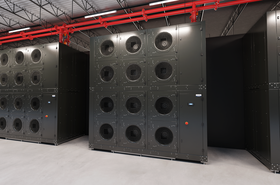
Sponsored Airedale launches parametric data center cooling range
Critical cooling specialist Airedale introduces AireWall ONE, designed by industry experts to deliver a flexible, efficient and global range of data center fan arrays geared towards scalability and sustainability
-
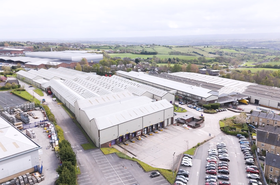
Sponsored Airedale by Modine to open third and largest UK manufacturing plant
The new site will produce precision cooling equipment to meet high demand from the fast-growing data center industry
-

Sponsored Liquid Gold: Airedale by Modine describes its 50th Anniversary as a “year of innovation”
Acquisition of TMGcore is reflective of a hybrid future

